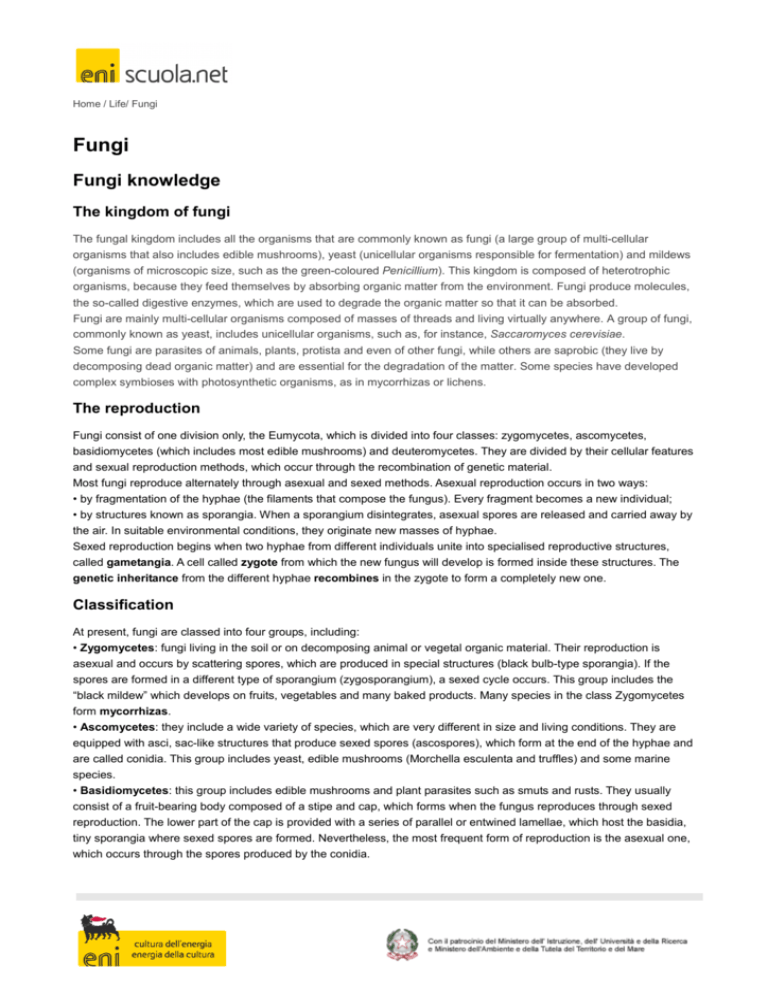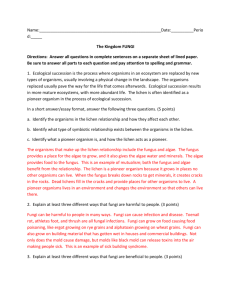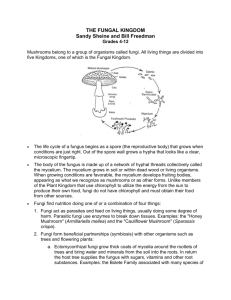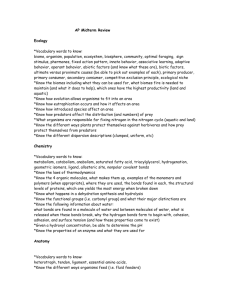Fungi knowledge
advertisement

Home / Life/ Fungi Fungi Fungi knowledge The kingdom of fungi The fungal kingdom includes all the organisms that are commonly known as fungi (a large group of multi-cellular organisms that also includes edible mushrooms), yeast (unicellular organisms responsible for fermentation) and mildews (organisms of microscopic size, such as the green-coloured Penicillium). This kingdom is composed of heterotrophic organisms, because they feed themselves by absorbing organic matter from the environment. Fungi produce molecules, the so-called digestive enzymes, which are used to degrade the organic matter so that it can be absorbed. Fungi are mainly multi-cellular organisms composed of masses of threads and living virtually anywhere. A group of fungi, commonly known as yeast, includes unicellular organisms, such as, for instance, Saccaromyces cerevisiae. Some fungi are parasites of animals, plants, protista and even of other fungi, while others are saprobic (they live by decomposing dead organic matter) and are essential for the degradation of the matter. Some species have developed complex symbioses with photosynthetic organisms, as in mycorrhizas or lichens. The reproduction Fungi consist of one division only, the Eumycota, which is divided into four classes: zygomycetes, ascomycetes, basidiomycetes (which includes most edible mushrooms) and deuteromycetes. They are divided by their cellular features and sexual reproduction methods, which occur through the recombination of genetic material. Most fungi reproduce alternately through asexual and sexed methods. Asexual reproduction occurs in two ways: • by fragmentation of the hyphae (the filaments that compose the fungus). Every fragment becomes a new individual; • by structures known as sporangia. When a sporangium disintegrates, asexual spores are released and carried away by the air. In suitable environmental conditions, they originate new masses of hyphae. Sexed reproduction begins when two hyphae from different individuals unite into specialised reproductive structures, called gametangia. A cell called zygote from which the new fungus will develop is formed inside these structures. The genetic inheritance from the different hyphae recombines in the zygote to form a completely new one. Classification At present, fungi are classed into four groups, including: • Zygomycetes: fungi living in the soil or on decomposing animal or vegetal organic material. Their reproduction is asexual and occurs by scattering spores, which are produced in special structures (black bulb-type sporangia). If the spores are formed in a different type of sporangium (zygosporangium), a sexed cycle occurs. This group includes the “black mildew” which develops on fruits, vegetables and many baked products. Many species in the class Zygomycetes form mycorrhizas. • Ascomycetes: they include a wide variety of species, which are very different in size and living conditions. They are equipped with asci, sac-like structures that produce sexed spores (ascospores), which form at the end of the hyphae and are called conidia. This group includes yeast, edible mushrooms (Morchella esculenta and truffles) and some marine species. • Basidiomycetes: this group includes edible mushrooms and plant parasites such as smuts and rusts. They usually consist of a fruit-bearing body composed of a stipe and cap, which forms when the fungus reproduces through sexed reproduction. The lower part of the cap is provided with a series of parallel or entwined lamellae, which host the basidia, tiny sporangia where sexed spores are formed. Nevertheless, the most frequent form of reproduction is the asexual one, which occurs through the spores produced by the conidia. Home / Life/ Fungi • Deuteromycetes: this group includes the species in which no sexual reproduction cycle has ever been observed and that cannot be grouped under any one of the other three classes. Why are not plants? Fungi come in a wide variety of forms and life cycles. As a consequence it is very hard to classify them. In the past, fungi were classed as plants and only after in-depth studies the features that distinguished them from both vegetal organisms and all the other eukaryote organisms were discovered, so that they could be considered as belonging to a completely different kingdom. One of the first essential differences from plants is that fungi are heterotrophic; secondly, their cellular walls are composed of chitin, a carbohydrate that lacks in plants but can be found in the external skeleton of insects and crustaceans. In addition, fungi can store glycogen as a reserve material just like animals do. How many species? Little is known about the first fungi to have appeared on Earth; these organisms must have derived from protista. These originated the first fungi, whose fossil finds date back to approximately 400 million years ago. At present, about 100,000 species of fungi are known, and it is estimated that at least 200,000 are still to be identified. The evolutionary links between the main classes of zygomycetes, ascomycetes and basidiomycetes are not clear yet, while the class deuteromycetes includes all the species in which no sexed reproduction cycle has ever been observed. The mycelium Yeast and some fungi are unicellular organisms, but most species are multi-cellular organisms, composed of masses of filaments known as hyphae, which altogether compose the mycelium or body of the fungus. This structure differs according to the function that the organism has to serve. Saprobic fungi have special hyphae, called rhizoids, which anchor the mycelium to the substrate, while some parasitic fungi develop hyphae, called haustoria, which invade the cells of the host organism. The hyphae in a mycelium grow very quickly, even more than one kilometre a day. The mycelium can be found in different forms: in single and scattered hyphae or as a fluffy mass, sometimes in very complex forms as in the case of edible mushrooms (boletus edulis, field mushroom, honey mushroom). They have a structure composed of a stipe and a cap which surfaces above ground level, while the part accommodating the reproductive structure of the fungus is underground (you will find various examples of the structure of mushrooms on the photo album). Distribution in the environment Fungi are spread anywhere and can live on their own or as parasites of other eukaryote organisms. Some species can tolerate adverse conditions, such as, for instance, extreme temperatures: some live even at 5-6 degrees below zero, others at temperatures above 50 degrees. Mildews are microscopic fungi that look like a white, grey, green or black dusty coating. They are usually visible on such foods as bread, jam and fruits in the form of a blue or green coating. Saprobic fungi Fungi and bacteria are the main decomposers of organic matter; the activity of these organisms is as essential for the endless functioning of the earth’s ecosystems as that of the producers of nutrients. As they feed on dead organic matter, saprophytic fungi decompose it into simple molecules that go back into the soil and can be reused by plants and all other organisms. Their ability to demolish organic matter has been used by man, in particular to destroy foods and clothes (cotton and leather items). Home / Life/ Fungi Symbiont fungi Many fungi are involved in close and long associations known as symbiotic associations, which are mutually beneficial to both organisms. Two of these associations, lichens and mycorrhizas, have enabled some photosynthetic organisms to colonise deserted environments. Lichens are the combination of a fungus with a green alga or cyanobacteria; they are the first colonisers of bare rocky areas, they survive even when dry, they need light, air and mineral salts. The fungus makes it easier to absorb mineral salts and water as well as to maintain suitable conditions for the photosynthetic process, while the alga or bacterium supplies food in the form of by-products of the photosynthetic process. Lichens are not only economically important, but they are also used as bio-indicators or to date geological events (such as landslides or the withdrawal of glaciers). They are winter food for reindeers in the Arctic regions, are used in perfumery and to produce some colours. Mycorrhizas are associations between fungi and plant roots. The fungus uses the organic substances produced by the plant, supplies the plant with the minerals contained in the soil and makes it easier for the roots to absorb water. Sometimes, these associations become vital for both organisms, as is the case for some orchids, whose seeds do not sprout without a specific symbiont fungus. In its turn, the fungus cannot grow without a plant. A surprising association is the one that occurs between some species of fungi and some species of ants, such as, for instance, the Atta cephalotes. The ants collect and break up leaves and petals of flowers, on which grow special fungi that can only be found in ant nests, where they find the perfect conditions to spread.








